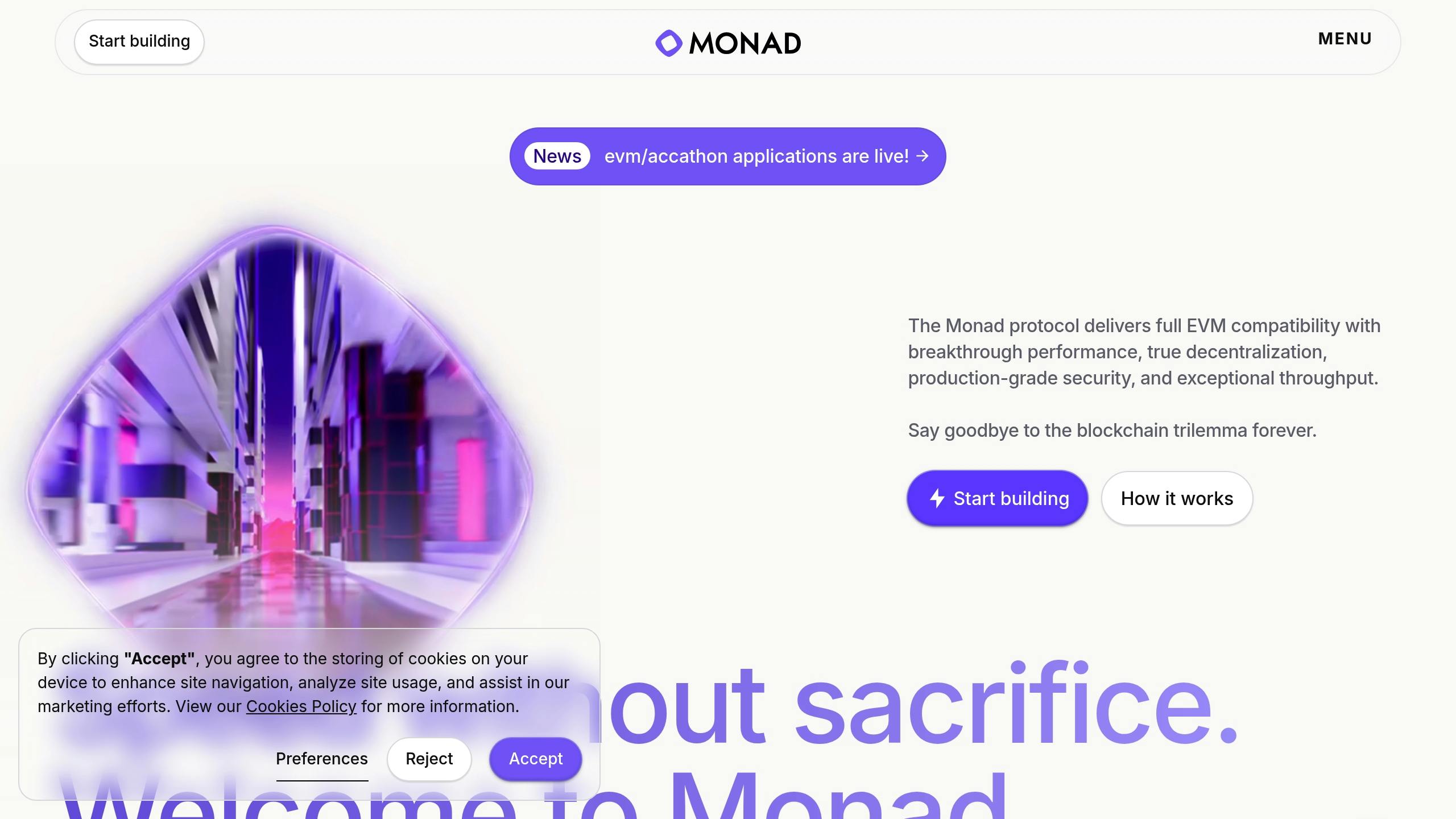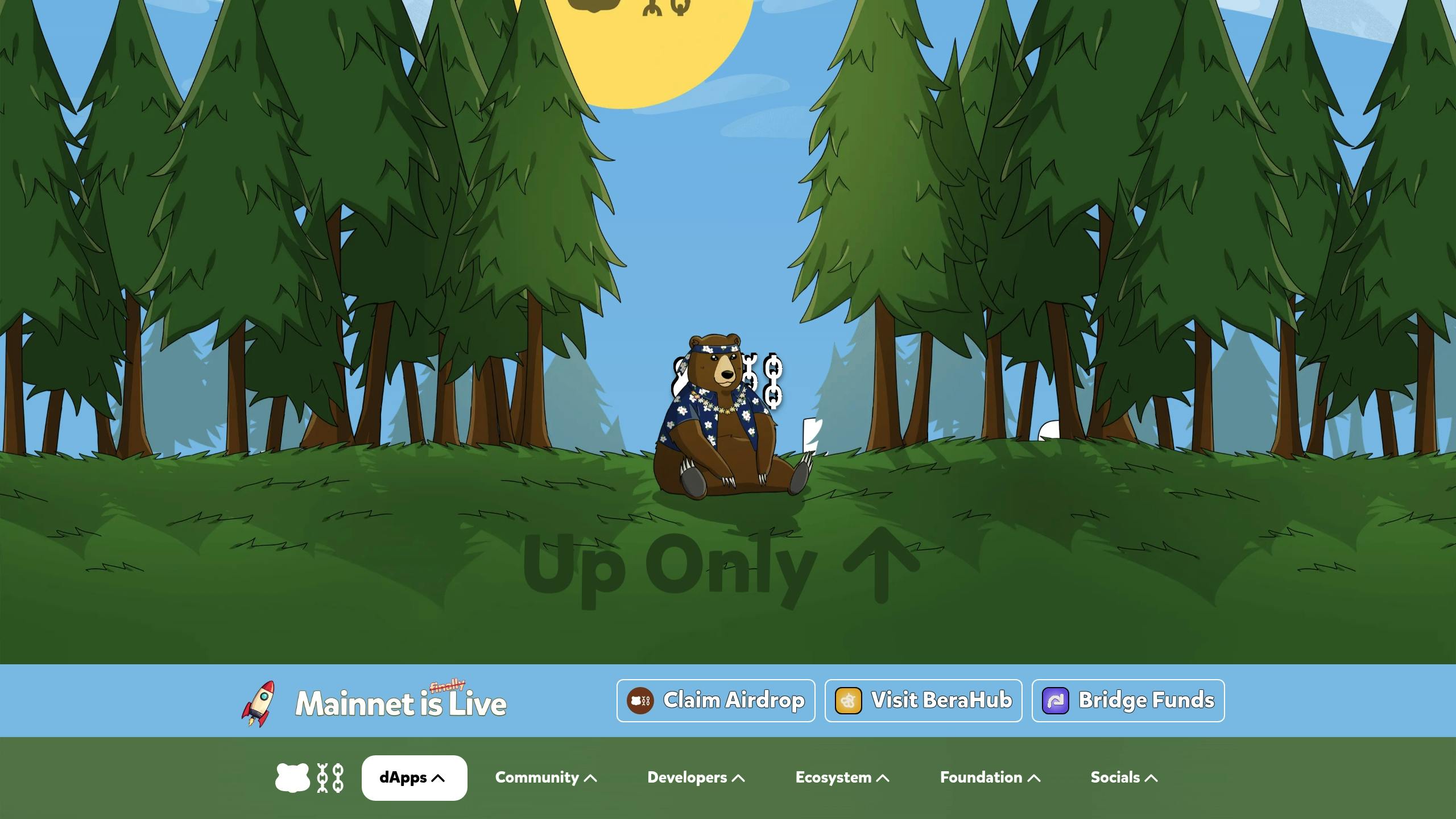Ethereum scaling in 2025 has brought three key players into the spotlight: Berachain, Monad, and MEGAEth. Each offers unique solutions to Ethereum’s transaction bottlenecks while staying EVM-compatible. Here’s a quick breakdown:
- Berachain: Uses Proof of Liquidity (PoL), staking liquidity instead of tokens for network security. Achieves up to 100,000 TPS with a focus on DeFi and liquidity incentives.
- Monad: Focuses on parallel execution, delivering 10,000 TPS with 1-second finality. Ideal for high-frequency trading and latency-sensitive applications.
- MEGAEth: Combines Layer 1 and Layer 2 technologies with MegaShards for modular scaling. Tailored for cross-chain trading and complex DeFi strategies.
Quick Comparison
| Feature | Berachain | Monad | MEGAEth |
|---|---|---|---|
| Consensus | Proof of Liquidity | MonadBFT | Modular PoS + zk-SNARKs |
| Throughput | 100,000 TPS | 10,000 TPS | Modular scaling |
| Best For | Liquidity-driven DeFi | High-frequency trading | Cross-chain trading |
| EVM Compatibility | Yes | Yes | Yes |
| Security Focus | Liquidity staking | Lightweight nodes | MEV-resistant sequencers |
Each platform addresses specific Ethereum challenges, whether it’s liquidity efficiency, transaction speed, or cross-chain strategies. Dive into the full article for a detailed comparison of their architectures and use cases.
Mega ETH vs Monad: The Battle To Shape Ethereum‘s Future

1. Berachain Core Features

Berachain introduces a Proof of Liquidity (PoL) consensus model, where validators can stake liquidity in decentralized exchanges instead of just tokens. This approach aims to make the ecosystem more capital-efficient[10]. During its testnet phase, the network demonstrated speeds of up to 100,000 transactions per second (TPS), thanks to optimized block production and parallel processing[2].
The platform operates on a two-token system:
- BERA: The main network token.
- BGT (Berachain Governance Token): A non-transferable token earned by staking BERA or liquidity-providing assets[10].
Berachain’s pre-launch liquidity program was a major success, attracting $3 billion in deposits[4]. Following its Binance listing, BERA’s price jumped from $7.85 to $14.83 in just 24 hours[4].
To handle network congestion, Berachain uses Continuous Fee Auctions, a gas pricing mechanism designed to stabilize fees during high traffic periods[6]. Developers benefit from full EVM compatibility, allowing them to use familiar tools like Hardhat, Truffle, and Remix. This also makes it easy to migrate Ethereum-based smart contracts to Berachain[7].
Security Measures
Berachain employs several layers of security, including:
- Audits by Trail of Bits and Certik.
- Formal verification for critical contracts.
- Gradual feature rollouts with stake limits.
- Regular penetration testing to identify vulnerabilities[8].
Institutional Support and Roadmap
With backing from major players like Polychain, Binance Labs, and Samsung Next[4], Berachain has already distributed over 79 million BERA tokens (representing 15.75% of its total supply)[4]. Looking ahead, the roadmap focuses on sharding and layer-2 optimizations to support high-frequency DeFi operations. The ultimate goal is to become a key infrastructure provider for complex financial applications on decentralized exchanges by 2027[9].
2. Monad System Architecture
Monad’s architecture takes a fresh approach to EVM-compatible blockchain design, focusing on optimizing execution rather than relying on rollup solutions [2]. This design directly tackles Ethereum’s congestion issues, particularly benefiting latency-sensitive DeFi trading.
At its core, Monad features a parallel execution engine that processes transactions simultaneously. This setup ensures 1-second transaction finality, making it ideal for high-frequency trading applications [5].
State Management and Consensus
Monad introduces MonadDB, a specialized state database tailored for Merkle Patricia Trie data [2]. By allowing most state data to be stored on SSDs instead of RAM, it significantly reduces hardware demands [5]. Its consensus layer, MonadBFT, enhances network communication while keeping decentralization intact with minimal hardware requirements [2]. Similar to Berachain’s Continuous Fee Auctions, Monad’s design ensures stability during high-load scenarios – critical for leveraged trading.
Technical Infrastructure
Monad employs several technical optimizations that distinguish it from other EVM chains:
- Pipelined Execution: Transactions are processed in a pipeline to boost throughput and lower latency [3].
- Optimistic Processing: Parallel transaction processing ensures consistency and efficiency [2].
- Scalable Architecture: The platform is designed to run efficiently on standard hardware [5].
Being fully EVM-compatible, Monad allows developers to use existing Ethereum tools and libraries while leveraging its improved performance. This has attracted interest from projects needing high-throughput blockchain solutions.
Development Progress
As of February 2025, Monad is gearing up for its mainnet launch in Q2 2025 [7]. Current development efforts include adding native staking and cross-chain functionality [7]. By focusing on both performance and decentralization, Monad aims to address the blockchain trilemma, delivering high throughput without sacrificing security [5].
sbb-itb-dd9e24a
3. MEGAEth Platform Design

MEGAEth takes a unique approach by blending Layer 1 and Layer 2 technologies, making it particularly suited for cross-chain leveraged trading strategies. It introduces a modular setup as an Ethereum Layer 2 scaling solution, combining optimistic rollups with its novel MegaShards system. This design separates execution, settlement, and data availability layers while ensuring smooth interaction between trading components.
Core Architecture
The platform’s modular architecture integrates optimistic rollups with MegaShards, enabling parallel transaction processing. Three standout features boost its performance:
- Parallel transaction processing through MegaShards.
- Just-in-time compilation, converting EVM bytecode into native machine code for faster execution.
- Batched operations using Mega-Transactions to cut down gas fees.
This shard-compatible system is tailored for handling complex, multi-position trading strategies, which are common in decentralized margin trading.
Advanced Security Framework
MEGAEth employs a decentralized sequencer network to limit MEV (Miner Extractable Value) extraction and ensure fairer transactions. This setup strikes a balance between security and the speed required for high-frequency trading.
Performance Optimizations
MEGAEth incorporates several technical advancements to boost performance, including:
- A load-responsive consensus mechanism that adapts to trading volume.
- Built-in zk-SNARKs for executing orders privately.
- MEV-resistant decentralized sequencers to enhance transaction reliability.
These features enable rapid trade execution, a critical factor for managing leveraged positions and liquidations.
Developer Environment
MEGAEth is fully compatible with the Ethereum Virtual Machine (EVM) and offers tailored SDKs for trading bots, along with compressed state storage to handle high-frequency data streams. The platform supports cross-chain bridges and standardized messaging protocols, allowing it to operate as both a standalone network and an Ethereum Layer 2 solution. This setup is designed to meet the needs of trading bots and algorithmic strategies that dominate decentralized margin markets.
Direct Comparison of Features
These solutions, built on distinct architectures, show noticeable differences in performance and design, each targeting specific needs in decentralized trading.
Performance and Scalability
Monad leads in throughput with its parallel execution model, while MEGAEth and Berachain focus on hybrid architectures and liquidity incentives, respectively. Monad’s 1-second finality allows near-instant position adjustments. On the other hand, MEGAEth’s fee structure adapts to market volatility, reducing unexpected liquidations.
| Performance Metrics | Berachain | Monad | MEGAEth |
|---|---|---|---|
| Throughput Focus | Liquidity incentives | Parallel execution | Modular scaling |
| Latency | Moderate | Ultra-low | Adaptive |
| Cost Profile | Mid-range | Lowest | Variable |
Security and Consensus Mechanisms
Each platform takes a unique approach to security, aligned with its scaling strategy. Berachain secures its network through liquidity stakes using Proof-of-Liquidity (PoL). MonadBFT emphasizes decentralization with lightweight nodes, while MEGAEth combines zk-SNARKs with Proof-of-Stake to balance speed and resistance to miner extractable value (MEV) risks. These security models are particularly relevant for margin trading environments.
Developer Experience and Compatibility
All platforms support EVM compatibility but cater to developers differently. Berachain enhances tools for liquidity management, Monad focuses on optimizing parallel processing, and MEGAEth facilitates workflows across multiple chains.
Data Handling
Monad’s SSD-optimized database stands out for its impact on transaction costs. Its MonadDb achieves a 1,000x improvement in state access speed compared to traditional systems [2][11]. This contrasts with Berachain’s trie structure, tailored for liquidity, and MEGAEth’s balanced storage approach.
Cross-chain Interoperability
MEGAEth excels in multi-chain strategies with its modular L1/L2 interoperability. Monad prioritizes efficient asset transfers through its bridging solutions, while Berachain focuses on enhancing internal DeFi composability.
Conclusion
Examining the latest EVM scaling solutions reveals that each platform caters to specific needs within the Ethereum ecosystem, offering tailored benefits for different user groups.
For Active Traders: If you’re into high-frequency trading, Monad is a standout. Its design ensures ultra-low gas fees while staying EVM-compatible, making it perfect for activities like arbitrage or frequent position adjustments.
For DeFi Developers: Berachain is ideal for those focused on liquidity. Its consensus mechanism rewards developers through native token incentives, creating a supportive environment for DeFi projects.
Here’s a quick breakdown of platforms and their strengths:
| Use Case | Recommended Platform | Key Advantage |
|---|---|---|
| High-Frequency Trading | Monad | Sub-second execution |
| Liquidity-Centric DeFi | Berachain | Staking-driven rewards |
| Cross-Chain Strategies | MEGAEth | Flexible fee structures |
Looking ahead to late 2025, Monad’s parallel execution model could make it a leader in transaction throughput. Meanwhile, Berachain’s focus on economic efficiency positions it as a solid choice for decentralized finance. MEGAEth, with its memory-optimized design, serves specific cross-chain trading needs.
Together, these platforms are helping Ethereum tackle its scalability challenges. For traders, this means unlocking opportunities like micro-position sizing and faster liquidation protections – features that were previously hindered by Ethereum’s limitations. By 2025, these advancements are expected to boost Ethereum’s scaling capacity by over 200x [1], paving the way for a more efficient and capable blockchain ecosystem.
